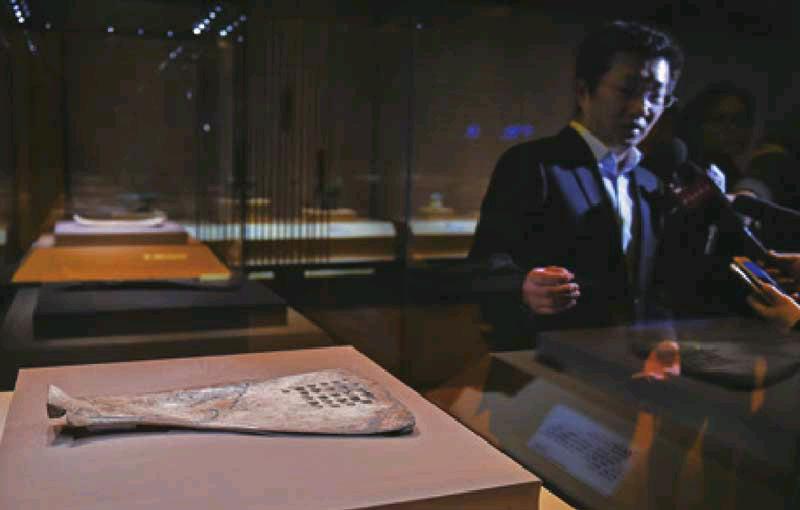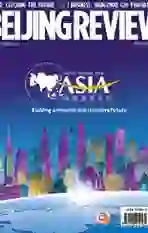The Queen Who Rode to War
2016-04-13ByZhaoWei
By+Zhao+Wei
Theres an unusual woman in Nan Yangs life. The 30-year-old Chinese language teacher with a passion for making classroom teaching vivid and related to Chinese history and culture is under the spell of someone who, according to legend, was one of the 60 wives of an ancient king.
That is not the only remarkable thing about Fu Hao.
Born at a time when society was dominated by men and women stayed in the home, Fu Hao led military campaigns to protect her kingdom and is hailed as Chinas first female general.
The story of the extraordinary queen unfolded in a wealth of details in 1976. Archaeologists unearthed red lacquer artifacts while excavating sites in the Yinxu area in central Chinas Henan Province, the site of the ruins of the ancient capital of the Shang Dynasty that ruled between 1600 and 1046 B.C. The items indicated the presence of the tomb of an important person and in the course of almost 20 days excavation, a total of nearly 2,000 objects were found. They identified the tomb as that of Queen Fu Hao.
More information came from oracle bones. Oracle bones—animal bones or turtle shells with inscriptions—were a special feature of the Shang Dynasty. They helped researchers piece together Fu Haos life.
A legend
She was the wife of Wu Ding, the dynastys 21st king, who entered into matrimonial alliances with neighboring clans to consolidate his kingdom. Though said to be one of 60 wives, she rose to prominence due to her intelligence and courage, winning the kings confidence. She had a son, Prince Jie, and died young, probably in her 40s.
Dead but not forgotten, Fu Haos life has been resurrected with a mesmerizing exhibition at the Capital Museum in Beijing. It is a timely tribute since 2016 marks the 40th anniversary of her tombs discovery. The special exhibition, titled Queen, Mother, General, fittingly opened on March 8, International Womens Day.
“This exhibition has been designed to present Fu Haos life in the form of a story. Queen, Mother, General outlines her social, family and historical roles, demonstrating her extraordinary life,” said Feng Hao, a PhD museology researcher and planner of the exhibition. “Taking Fu Hao as a typical case, we have shown the contribution of women in ancient society.”
Nan, an avid museum-goer, is also a volunteer expositor at museum exhibitions. He has been assigned to guide visitors at the exhibition, explaining its significance and pointing out objects of special interest.
The sprawling exhibition hall is divided into six parts, starting with the introductory ques- tion, “Who is she?” It helps visitors walk into the Shang Dynasty era with an overview of Fu Haos identity, as well as the importance of the excavation of her tomb.
Four chronological segments follow. Her Age describes the time she lived in, while Her Life shines a light on Fu Haos days as a wife, mother and queen who assisted the king with court affairs. Her Story focuses on wars and sacrificial ceremonies, revealing the queens extraordinary performance as a general in action, as well as conducting elaborate religious rituals, a role usually reserved for men. The last section, Her Funeral, strengthens her influence through the ceremony of remembrance by her family members and subjects.
In a remarkable coincidence, Zheng Zhenxiang, the archaeologist who directed the excavation of Fu Haos tomb, is the first female archaeologist in China. Zheng spent 36 years in Yinxu and witnessed its archaeological development. In 2006, Yinxu was listed as one of UNESCO World Cultural Heritage Sites.
The exhibition concludes with an acknowledgement of the unremitting efforts of Zheng and her team.
Modern technology
The ingenious display adds further interest. There is a simulation of oracle bones. Visitors realize what they looked like while a video shows how the inscriptions were made and the link between the inscriptions and modern Chinese characters.
“Now I know how Chinese characters came into existence,” said Tian Zhenping, a visitor in her 70s who came to the exhibition with three neighbors of the same age. “I identified my family name Tian on the bones immediately since it looked just the same at that time.” Tian and her friends came from Daxing, a suburban district in south Beijing.
The third section features a wealth of objects whose functions are described for the benefit of viewers. Some of them have modernday replicas for visitors to touch and hold.
A boy gasped when he lifted the replica of a gu, a bronze goblet used 3,000 years ago for drinking. “I never thought their goblets were so heavy,” he said. “The Shang people must have been very strong!”
A highlight of the exhibition is the use of virtual reality (VR) technology. The Capital Museum rebuilt the coffin chamber and used VR technology to give visitors an animated three dimensional (3D) view of Fu Haos sevenlevel tomb in Yinxu.
“I felt a little dizzy at the beginning but the experience was amazing, like I was an archaeologist, deep down inside the tomb,” said Chen Yiguang, an art industry professional.
“Our young visitors grow up in the midst of electronic gadgets,” Feng said, explaining the reasons for introducing modern technology in the exhibition. “From a design standpoint, this exhibition is more vivid. We have been working on using new technologies to improve our displays, make them more realistic, especially to make young visitors more willing to understand history and culture. There is no better way than 3D animation and VR to explain the burial process and the structure of the tomb, .”
The exhibition has had more than 75,000 visitors and will be on display till June 26. Some of the visitors left their remarks in the visitors book, praising the storytelling, the female perspective, and the artistic atmosphere.
Nan is happy at the response but he is planning to do more to rope in other young visitors. He plans to introduce museum education in his classroom. As a step toward that, he plans to organize a trip to the exhibition for his students.
“Its like moving the classroom into the museum,” he said. “I would be preparing not just text for my lessons, but my matter would be history and culture. These are topics that Im interested in, and I hope my students will enjoy the experience and begin to learn from the splendid cultural treasures.”
